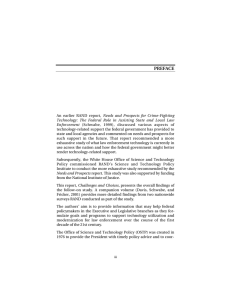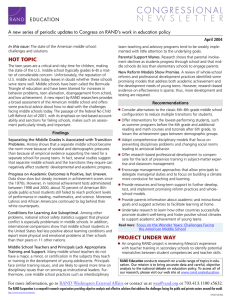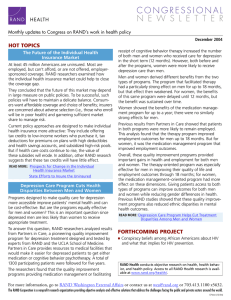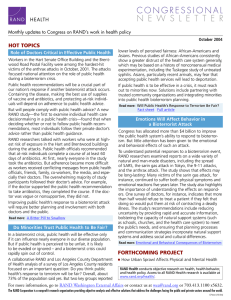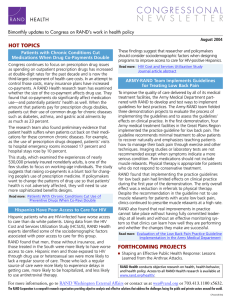HOT TOPIC California’s K–12 Public Schools
advertisement
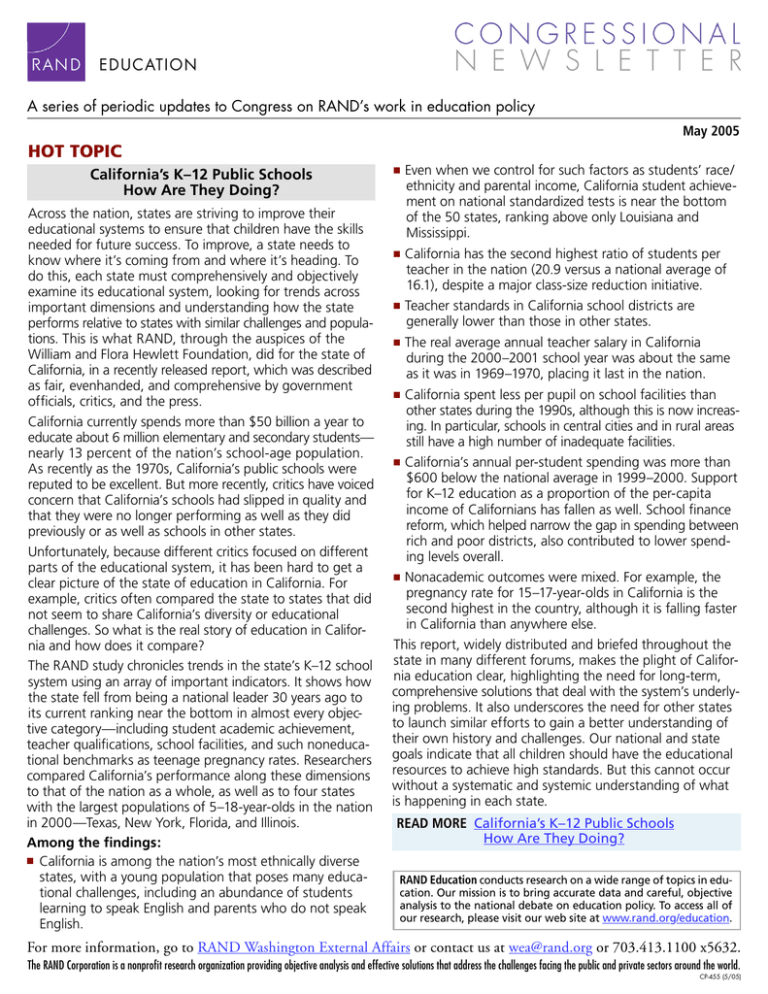
A series of periodic updates to Congress on RAND’s work in education policy May 2005 HOT TOPIC California’s K–12 Public Schools How Are They Doing? Across the nation, states are striving to improve their educational systems to ensure that children have the skills needed for future success. To improve, a state needs to know where it’s coming from and where it’s heading. To do this, each state must comprehensively and objectively examine its educational system, looking for trends across important dimensions and understanding how the state performs relative to states with similar challenges and populations. This is what RAND, through the auspices of the William and Flora Hewlett Foundation, did for the state of California, in a recently released report, which was described as fair, evenhanded, and comprehensive by government officials, critics, and the press. California currently spends more than $50 billion a year to educate about 6 million elementary and secondary students— nearly 13 percent of the nation’s school-age population. As recently as the 1970s, California’s public schools were reputed to be excellent. But more recently, critics have voiced concern that California’s schools had slipped in quality and that they were no longer performing as well as they did previously or as well as schools in other states. Unfortunately, because different critics focused on different parts of the educational system, it has been hard to get a clear picture of the state of education in California. For example, critics often compared the state to states that did not seem to share California’s diversity or educational challenges. So what is the real story of education in California and how does it compare? The RAND study chronicles trends in the state’s K–12 school system using an array of important indicators. It shows how the state fell from being a national leader 30 years ago to its current ranking near the bottom in almost every objective category—including student academic achievement, teacher qualifications, school facilities, and such noneducational benchmarks as teenage pregnancy rates. Researchers compared California’s performance along these dimensions to that of the nation as a whole, as well as to four states with the largest populations of 5–18-year-olds in the nation in 2000—Texas, New York, Florida, and Illinois. Among the findings: ■ California is among the nation’s most ethnically diverse states, with a young population that poses many educational challenges, including an abundance of students learning to speak English and parents who do not speak English. ■ Even when we control for such factors as students’ race/ ethnicity and parental income, California student achievement on national standardized tests is near the bottom of the 50 states, ranking above only Louisiana and Mississippi. ■ California has the second highest ratio of students per teacher in the nation (20.9 versus a national average of 16.1), despite a major class-size reduction initiative. ■ Teacher standards in California school districts are generally lower than those in other states. ■ The real average annual teacher salary in California during the 2000–2001 school year was about the same as it was in 1969–1970, placing it last in the nation. ■ California spent less per pupil on school facilities than other states during the 1990s, although this is now increasing. In particular, schools in central cities and in rural areas still have a high number of inadequate facilities. ■ California’s annual per-student spending was more than $600 below the national average in 1999–2000. Support for K–12 education as a proportion of the per-capita income of Californians has fallen as well. School finance reform, which helped narrow the gap in spending between rich and poor districts, also contributed to lower spending levels overall. Nonacademic outcomes were mixed. For example, the pregnancy rate for 15–17-year-olds in California is the second highest in the country, although it is falling faster in California than anywhere else. This report, widely distributed and briefed throughout the state in many different forums, makes the plight of California education clear, highlighting the need for long-term, comprehensive solutions that deal with the system’s underlying problems. It also underscores the need for other states to launch similar efforts to gain a better understanding of their own history and challenges. Our national and state goals indicate that all children should have the educational resources to achieve high standards. But this cannot occur without a systematic and systemic understanding of what is happening in each state. ■ READ MORE California’s K–12 Public Schools How Are They Doing? RAND Education conducts research on a wide range of topics in edu- cation. Our mission is to bring accurate data and careful, objective analysis to the national debate on education policy. To access all of our research, please visit our web site at www.rand.org/education. For more information, go to RAND Washington External Affairs or contact us at wea@rand.org or 703.413.1100 x5632. The RAND Corporation is a nonprofit research organization providing objective analysis and effective solutions that address the challenges facing the public and private sectors around the world. CP-455 (5/05)





